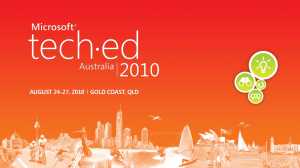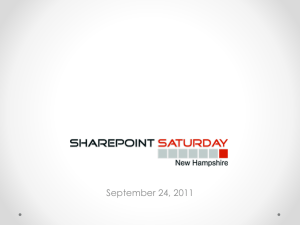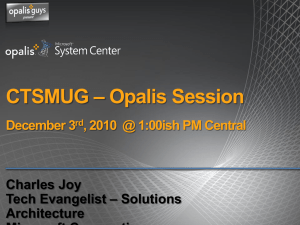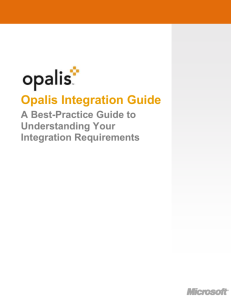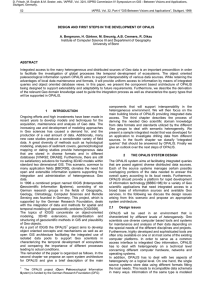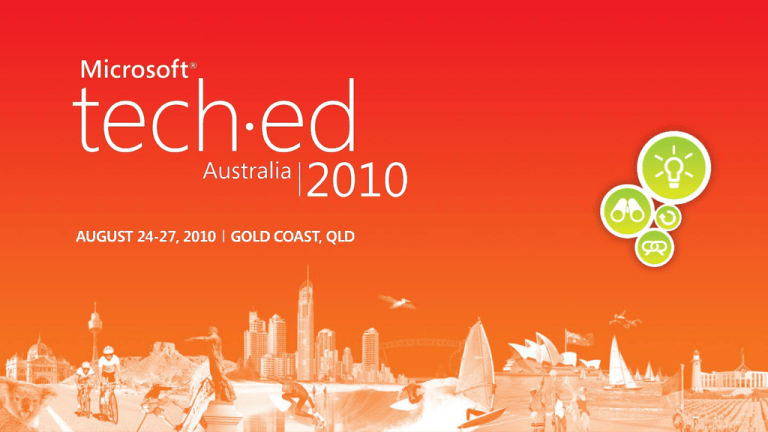
Pre-Day Seminar Series
System Center – IT Process Automation
with Opalis and Gateway to the Cloud
Charles Joy
Tech Evangelist – Solutions Architecture
System Center
Microsoft Corporation
Seminar Objectives and Takeaways
Opalis Integration Server
Gain a greater understanding of Opalis Integration Server
and its primary uses
Recognize where Opalis fits within System Center and the various
features within the offering
Recognize common use cases for Opalis
Identify opportunities where Opalis can help transform your
datacenter into the datacenter of the future
3
What is Opalis Integration Server?
o·pa·lis
[oh-pal-is]
-noun
1.
The newest member of the
Microsoft System Center Suite;
providing automation,
orchestration, and integration
for IT management tools
throughout the data center.
2.
The best* way to Integrate,
Orchestrate and Automate your
Datacenter.
*In my opinion
4
System Center Server Management Suite
Service Manager
Remedy
Action Request System
.
OpenView Operations
5
What Does Opalis Do?
Opalis provides IT Process Automation (ITPA), also known as Run Book Automation (RBA),
which is the ability to orchestrate and integrate IT management tools through workflows.
• Helps meet strategic IT goals through
improving service delivery
• Replaces manual, resource-intensive,
and error-prone activities
• Typically crosses multiple IT
components, disciplines, and silos
6
Data
Protection &
Recovery
Configuration
Management
Server
Compliance
End-To-End
Monitoring
(Physical &
Virtual)
How Are Customers Using Opalis?
Incident Management
Orchestrate incident
management and resolution
Integrate across monitoring
tools, service desks, and
configuration management
databases (CMDBs)
7
Virtual Machine Life-Cycle
Management
Change and Configuration
Management
Automate provisioning,
resource allocation and
retirement
Scale automated configuration
across platforms and tools
Extend virtual machine
management to the cloud
Ensure reliable change with
intelligent workflow branching
Integration for some System Center Products to be released in 2010
Data Center Automation Use Cases
Virtual Life Cycle Management
User & Service Provisioning
Closed Loop Compliance
Data Refresh/Publication
Infrastructure Remediation
RBA – Task Automation
Server Maintenance
OS Maintenance
File System Maintenance
Database Maintenance
Service Maintenance
Backup/Recovery Maintenance
8
Processes and IT Silos
IT Silos
Update
request
Update
request
Update CI and assets systems
Server
Network
9
Provisioning
Storage
Create CI
Coordinate audit, compliance and change
Virtual
Security
Update & close
request
Test VM
Deploy
Applications
Verify
Application
Orchestrate lifecycle management
Stop VM
Clone new
Update
properties
Patch , VM
user on-boarding,
password reset
Provision, verify, manage & retire
Detach Storage
Provision, verify, manage & retire
Provision, verify, manage & retire
Detach Network Adapter
Cloud Computing
Create
incident
Retire CI
Configuration
Add to
Ops Manager
Integrate service desks with data center tools
Monitor
Service
request
Change &
Compliance
Asset/CMDB
Remove from
Ops Manager
Virtual Service Management
Service Desk
Triage & diagnose
Incident
Response
Event Mgmt
Silo Processes
Incident Triage Process - Manual
Monitoring
Test &
Diagnostics
10
Service Desk 1
Service Desk 2
Infrastructure
Configuration
Management
Incident Triage Process with Automation
Monitoring
SD1 Incident ID
SD2 Incident ID
New Event
Details
Service Desk 1
SD2 Incident ID
SD1 Incident ID
Event Details
Fault Verification
Diagnostic Results
CI & Effected
Service Data
Service Desk 2
SD1 Incident
Details
SD2 Incident ID
Workflow + Data Bus
Diagnostic
Results
Run Diagnostic
Test &
Diagnostics
11
Verification
Result
Verify
Fault
Infrastructure
CI & Related
Service Data
Lookup CI
Configuration
Management
The Opalis Components
Opalis Integration Server
Workflow
Designer
Operator’s
Console
GUI
(Design, manage, report)
Process
Catalogs
12
Data Store
(Store process logic)
Automation Platform
Action Servers
(Run processes)
Integration
Packs
Opalis Integration Packs
Microsoft Active Directory
HP Operations for UNIX
Microsoft Systems Management Server
HP Operations Windows
Microsoft Operations Manager
HP Operations Solaris
Microsoft Configuration Manager**
HP Network Node Manager
Microsoft Virtual Machine Manager**
HP Service Desk
Microsoft Data Protection Manager**
HP Service Manager
Microsoft Service Manager**
HP Asset Manager
BMC Atrium CMDB
HP iLO 2
BMC Remedy AR System
FTP
BMC Event Manager
Symantec VERITAS NetBackup
BMC Patrol
IBM Tivoli Enterprise Console
BMC BladeLogic Operations Manager
IBM Tivoli Netcool/Omnibus
CA AutoSys
IBM Tivoli Storage Manager
CA eHealth
EMC Smarts InCharge
CA Service Desk
VMware VI / vSphere
CA SPECTRUM
UNIX Integration
CA Unicenter NSM
**Roadmap 2010
Why Opalis?
Multi-vendor integration, no rip & replace or
vendor lock-in
Pre-built activities & workflow processes to speed
time to value
Publish and subscribe data bus to share data and
initiate tasks within the silos
Configuration of workflows is done without coding
or scripting
Intelligent workflows with rule-based branching
14
Identifying Opportunities
Alignment with ITIL/MOF, best practice initiatives
High number of manual processes
undocumented
inconsistent
error prone
slow
Processes are complex and require extensive interaction with
other software
Maintenance of scripts is a burden
15
Which Verticals Are Using Opalis Today
Government/Military
Education
Telecom
High Tech
Manufacturing
Finance/Banking
Insurance
Global Solution Providers
16
System Center - Opalis Home
Microsoft Pathways – Opalis
Blog D'Joy
TechNet Webcasts and Virtual Lab!
OPALIS RESOURCES
17
Related Content
MGT302 - Opalis IT Process Automation:
Introduction &Technical Overview
MGT200 – System Center Roadmap and Strategy
MGT201 – Don’t Waste a Crisis
VOC301 - Enterprise Service Level Monitoring
at Queensland Department Communities
18
© 2008 Microsoft Corporation. All rights reserved. Microsoft, Windows, Windows Vista and other product names are or may be registered trademarks and/or trademarks in the U.S. and/or other countries.
The information herein is for informational purposes only and represents the current view of Microsoft Corporation as of the date of this presentation. Because Microsoft must respond to changing market conditions, it should
not be interpreted to be a commitment on the part of Microsoft, and Microsoft cannot guarantee the accuracy of any information provided after the date of this presentation. MICROSOFT MAKES NO WARRANTIES, EXPRESS,
IMPLIED OR STATUTORY, AS TO THE INFORMATION IN THIS PRESENTATION.

